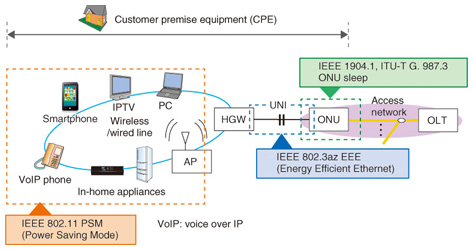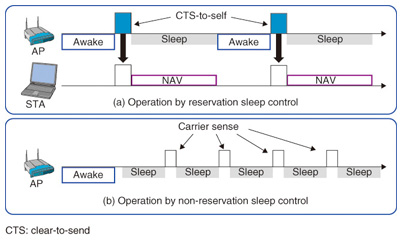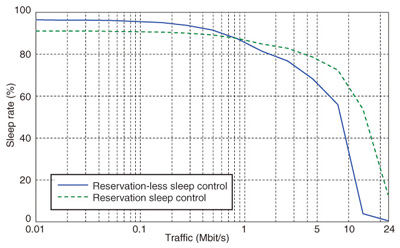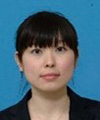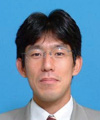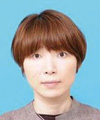 |
|||||||||
|
|
|||||||||
|
Feature Articles: Current Status of Technology Development Toward Energy-saving––For Continuous Telecommunications Infrastructure Connections 24/7 Vol. 12, No. 3, pp. 29–36, Mar. 2014. https://doi.org/10.53829/ntr201403fa5 Power-saving Technologies for Network Equipment and Their Application— ONU/wireless-LAN Sleep TechnologiesAbstractThe amount of power consumed by equipment installed at various locations in the network is increasing with the spread of broadband services. In particular, a large amount of equipment is installed in user homes, and this home equipment accounts for most of the power consumed by the network. Reducing the power consumed by home network equipment is therefore becoming increasingly important considering the recent tightening of the electric power supply in Japan, as well as global warming concerns. This article introduces power-saving technology for in-home network equipment and power-saving technology for wireless local area networks. Keywords: ONU sleep, wireless LAN, power-saving technology 1. IntroductionNetwork power consumption is increasing along with the spread of broadband services. The increasing amount of equipment that must be installed to provide services is given as the main reason for this rise in power consumption, and as it turns out, equipment installed on the end-user side in homes, or customer premise equipment (CPE), consumes most of the power in the network. For example, optical network units (ONUs) on the user side used for domestic fixed-line broadband services are responsible for 60% of all power consumed by the network (Fig. 1) [1]. The power consumed by one ONU is actually small (on the order of several watts), but because there are more than 10 million ONUs installed, their total power consumption is huge. If we now include the power consumed by wireless local area network (LAN) access points (APs) and home gateways (HGWs), this proportion of consumed power becomes even higher. In fact, we can surmise that the total amount of power consumed by this equipment is about the same as that produced by a single medium-scale thermal power plant. Such an enormous amount of power can place a large load on the environment. Power-saving technology for network equipment is therefore expected to become exceedingly important in the years to come. In this article, we introduce the most promising power-saving technologies and applications for access network equipment.
2. Power consumption in CPE and power-saving technology2.1 PON system and ONU sleep technologyAt present, the main network scheme for achieving fiber to the home (FTTH) is the passive optical network (PON). A key feature of PON is that multiple ONUs share an optical fiber and a single optical line terminal (OLT) in the central station, which makes for economical provision of broadband services (Fig. 1). The main type of PON system currently used in Japan is Gigabit Ethernet-PON (GE-PON), which has a transmission capacity of 1 Gbit/s; a next-generation 10-Gbit/s-class PON is now under development. A typical power-saving technology in PON systems is ONU sleep. This technology reduces power consumption by turning some ONU functions and devices off during times when there is no traffic. A number of sleep methods have been standardized by international bodies such as the International Telecommunication Union, Telecommunication Standardization Sector (ITU-T) and the Institute of Electrical and Electronics Engineers (IEEE). ITU-T Recommendation G.987.3, for example, prescribes (1) a dozing mode that turns off ONU transmit functions in the absence of upstream signals and (2) a cyclic sleep mode that turns off the transceiver intermittently in the absence of upstream/downstream signals. In cyclic sleep mode, an ONU wakes up for only a very short period of time (Fig. 2), and while this mode requires advanced control techniques between the OLT and ONU to determine whether sleep should be continued, it can be expected to provide stable communications quality and to conserve power. In summary, basic ONU sleep technology as described above has come to be prescribed as a standard, but technology for achieving an even greater power-saving effect and sleep technology that can reduce power consumption in coordination with peripheral devices are now being pursued as a field of research that is expected to expand in the future.
2.2 Sleep technology in wireless LANA wireless LAN terminal or station (STA) is normally used in an awake state, which means that power will usually be supplied by a battery. A variety of power-saving techniques have consequently been devised at the control and device levels. For example, there is a sleep control function prescribed in the IEEE 802.11 standard that enables an STA to make a transition from its usual awake state to a sleep state. In the sleep state, power to some circuits is suspended, which significantly reduces power consumption. In this state, however, no signals can be transmitted or received. A wireless LAN AP, on the other hand, is usually connected to a commercial power supply, and as a result, no power-saving functions have yet to be prescribed. However, APs are beginning to be deployed in increasing numbers to cope with the many and diverse devices equipped with wireless LAN functions and to offload mobile traffic originating in the large number of smartphones now in use. Greater environmental consciousness is also driving expectations for power saving in APs. 3. Advanced sleep technologies and their applicationWe introduce here three advanced ONU/wireless-LAN sleep technologies coming out of NTT laboratories. (1) Deep sleep technology that maintains a telephone standby state during long power outages at the time of a disaster by keeping ONU power consumption to a bare minimum. (2) Coordinated sleep technology that improves the power-saving effect through coordination between the ONU and other CPE components. (3) Wireless LAN AP sleep technology that aims to save power in wireless LAN APs. 3.1 Deep sleep technologyFTTH connects the user’s house with the NTT exchange via optical fiber to provide the user with a broadband Internet connection and telephone and video services. The FTTH configuration is such that if a power outage occurs because of a natural disaster or other unforeseen event, operations may be suspended, and services may be unavailable. Unlike conventional telephone lines, optical fiber cannot easily supply power from the exchange, and consequently, finding a way to ensure communications during emergencies has become an issue of concern. One method that can be considered for providing services during a power outage is to equip ONU equipment with a battery so that the ONU can be operated by battery power at such times. Here, however, operating an ONU by battery for a relatively long time while maintaining an active state would require an extremely large battery capacity, so greatly reducing the amount of power consumed by the ONU itself is crucial. At the same time, there will invariably be a need to make emergency calls at the time of a power outage, so a mechanism that would allow calls to be made and received during a crisis must be investigated. In light of the above, we have undertaken research on saving power through a deep sleep scheme that provides for long-term telephone-call standby during power outages. As shown in Fig. 3(a), deep sleep suspends nearly all ONU functions and sleeps in long one-second intervals, resulting in significant power savings compared to conventional ONU sleep. In addition, deep sleep applies conventional ONU sleep while a call is in progress to reduce power consumption during this time. We evaluated the deep-sleep effect using test equipment and found that power consumption could be reduced to about 200 mW in the deep-sleep state compared to 4 W in the active state, as shown in Fig. 3(b).
While deep sleep technology can greatly reduce the power consumed by an ONU, almost all ONU functions are suspended in this mode, which means that arriving packets are simply discarded. In the case of an incoming call on an ordinary IP (Internet protocol) phone, a call control server sends the packets requesting call reception and will resend those packets if they do not arrive at their destination. However, if the packets continuously fail to be received and a timeout occurs, no call can be received, as shown in Fig. 4(a). However, to receive re-sent packets and ensure reception of an incoming call, the ONU must maintain an active state in which power consumption is high for a certain length of time, as shown in Fig. 4(b). We therefore investigated a method for shortening this time through cooperative operation with equipment on the exchange side. In this method, the OLT buffers incoming-call packets and sends them out synchronized with the ONU active state, as shown in Fig. 4(c). In this way, the ONU can shorten its active time for receiving incoming-call packets, thereby obtaining a large power-saving effect. In an evaluation using test equipment, we found that the amount of power consumed by an ONU in a standby state allowing incoming calls can be reduced to less than 1 W on average. This result demonstrates the potential of deep sleep as a viable technology.
3.2 Coordinated sleep technologyThe number of CPE units installed in homes is increasing as the home network market expands. At the same time, an increase in environmental consciousness is driving the spread of CPE equipped with power-saving functions such as those described in IEEE 802.3az Energy Efficient Ethernet (EEE) and IEEE 802.11 Power Saving Mode (PSM). However, while most CPE equipment is connected to the ONU via the HGW (Fig. 5), these power-saving functions operate independently of each other, and as a result, they do not necessarily operate optimally from the viewpoint of the entire network. For example, if a power save timing mismatch occurs between communicating with another CPE and entering a power-saving state, a transition will unavoidably be made to a normal state before a power-saving effect can be obtained. In fact, a reduced power-saving effect caused by such a mismatch in communication timing can be particularly noticeable in CPE such as ONUs where traffic tends to concentrate. In response to this situation, we are researching and developing coordinated sleep technology that greatly increases the power-saving effect by synchronizing communication timing between the ONU and HGW.
The ONU and HGW connect and communicate via a UNI (user network interface) that interconnects the telecommunications carrier’s equipment and user equipment. During ONU sleep, however, any input of upstream traffic from the HGW cancels ONU sleep, forcing the ONU to revert to its normal state. In particular, an ongoing inflow of traffic from the HGW frequently disturbs ONU sleep, thereby degrading the power-saving effect. To obtain a power-saving effect through ONU sleep, a sleep state ranging from several tens to several hundreds of milliseconds must be secured (depending on the type of transceiver). An effective method in this regard is to temporarily suspend the inflow of traffic. We therefore developed a technology for maintaining the ONU sleep state by notifying the HGW side of ONU sleep and buffering upstream frames at the HGW during ONU sleep. We evaluated this technology in a 10G-EPON system that complies with the ONU sleep mechanism specified in IEEE Std. 1904.1 SIEPON and IEEE 802.3az EEE, and we succeeded in reducing power consumption in target components by about 40% compared to past values. We consider that coordinated sleep technology between the ONU and HGW can also be effective for CPE with wireless LAN functions. Looking forward, we seek a large, overall power-saving effect by establishing coordinated operation among many units of equipment. 3.3 Wireless LAN AP sleep technologyAs described earlier, power-saving functions for STAs have come to be standardized, but no such functions have been specified for APs. We have proposed two types of power-saving technologies to rectify this situation: reservation sleep control and reservation-less sleep control [3], [4]. Either control method maintains connectivity with the AP without having to change or add functions in STAs. Here, we outline each of these methods and their respective effects on power saving. Operation by reservation sleep control is outlined in Fig. 6(a). In this control method, the AP first notifies the STA of a transmission-prohibited period, that is, a network allocation vector (NAV), and then enters a sleep state. An STA in which a NAV is set transmits no signals during this AP sleep period and therefore generates no upstream packet loss. Operation by reservation-less sleep control is outlined in Fig. 6(b). In this case, the AP alternates between a sleep state and carrier-sense interval in short cycles. In contrast to reservation sleep control, this control method does not notify the STA of the NAV, which means that there can be times in which the AP fails to receive signals transmitted from the STA. However, the AP can sense signals transmitted from the STA during the carrier-sense interval, and if it does, it will make a transition from a sleep state to an awake state and receive frames that have been re-sent from the STA.
The results of simulating sleep efficiency using these control methods are shown in Fig. 7. Both of these control methods exhibit a traffic dependency, and while reservation-less sleep control is superior in the relatively low traffic region, the reservation sleep control is superior in the relatively high traffic region. This is because in the low traffic region, the difference in sleep per unit time between reservation and reservation-less sleep control has an effect on sleep efficiency, while in the high traffic region, re-sent frames frequently appear in reservation-less sleep control, thereby decreasing the opportunities for entering the sleep state.
In future research, we plan to clarify the performance and applicable regions of sleep control methods using test equipment and more precise evaluation techniques. 4. Future developmentsThe amount of communication equipment installed on the user side is expected to continue increasing with the spread of broadband, and it is safe to say that the overall amount of power consumed by this equipment will also increase. It can also be assumed, however, that the demand for power-saving communications devices will become increasingly stronger in order to reduce the load on the environment. Because the sleep technologies introduced in this article are power-saving technologies based on communication protocols, they can help achieve a power-saving effect in all types of equipment supporting those protocols. These technologies should therefore be able to contribute greatly to the deployment of a power-saving telecommunications network. References
|
|||||||||













